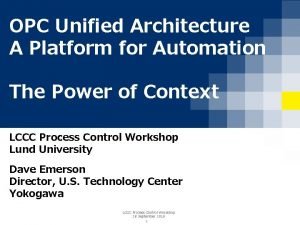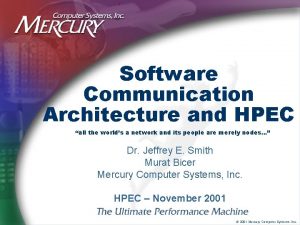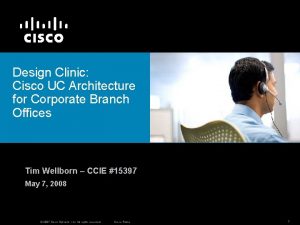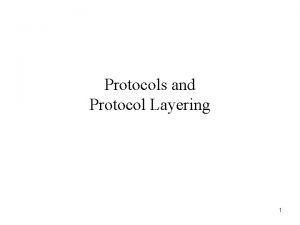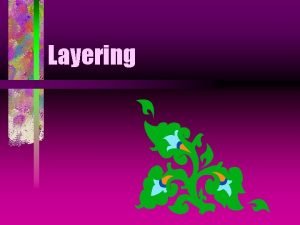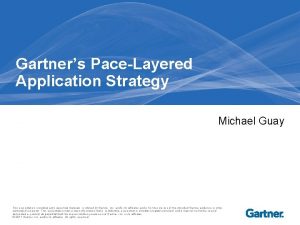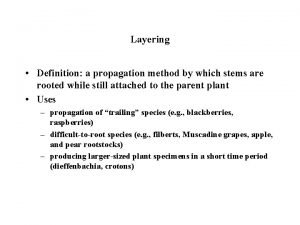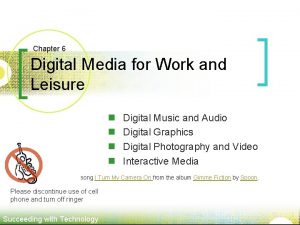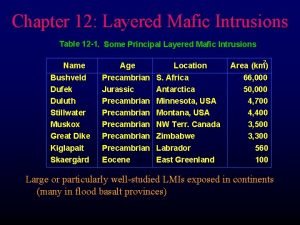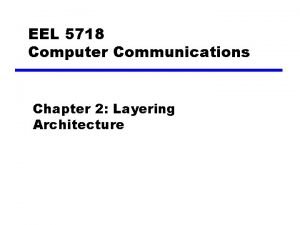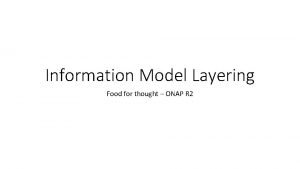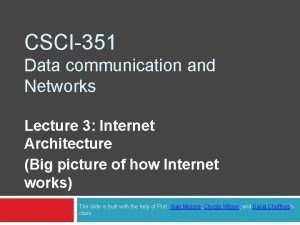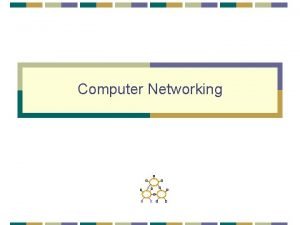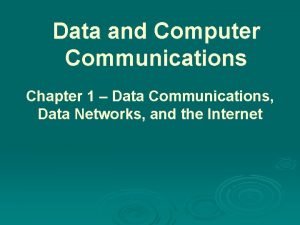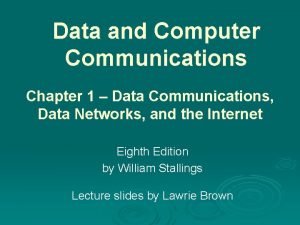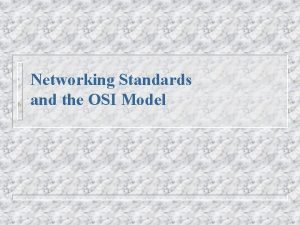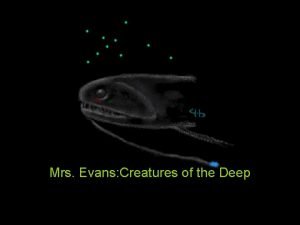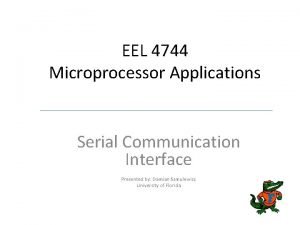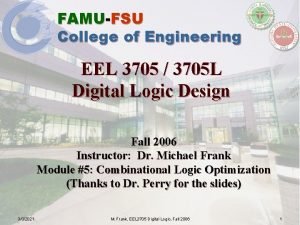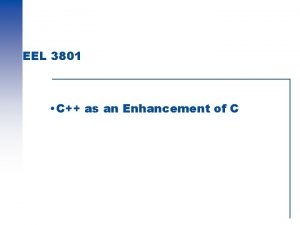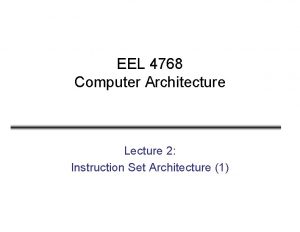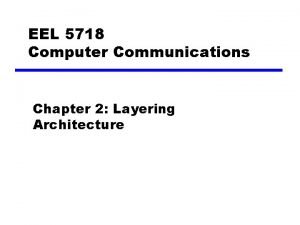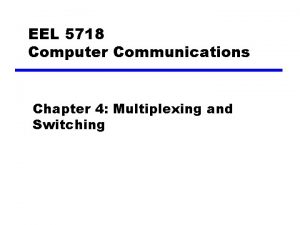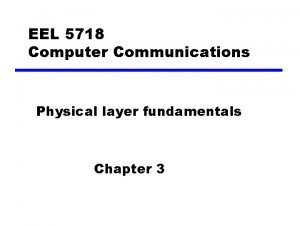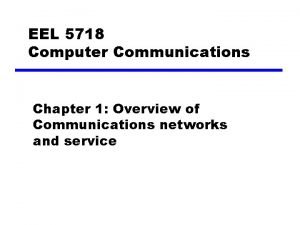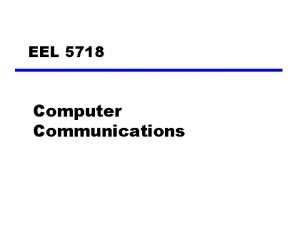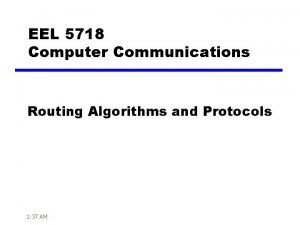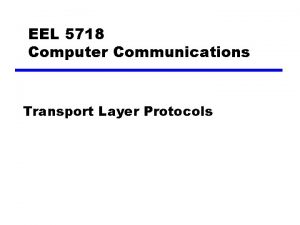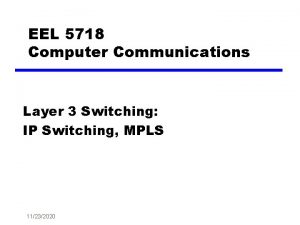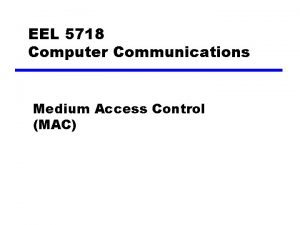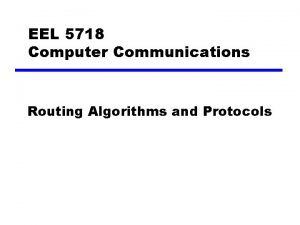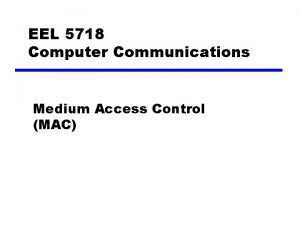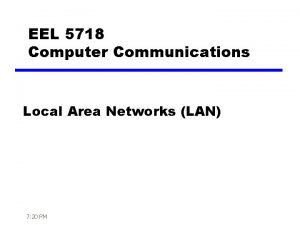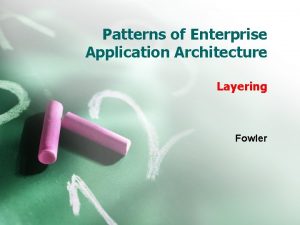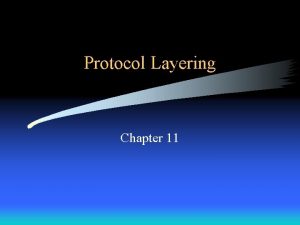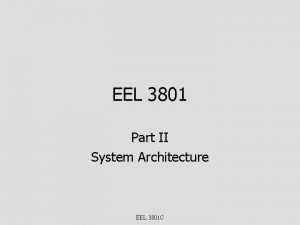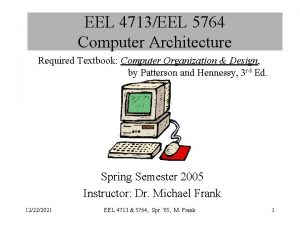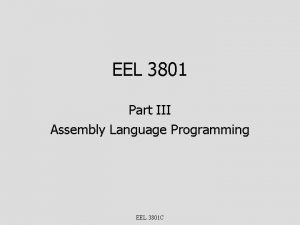EEL 5718 Computer Communications Chapter 2 Layering Architecture











































- Slides: 43

EEL 5718 Computer Communications Chapter 2: Layering Architecture

Outline • Examples of layering • OSI Reference Model • TCP/IP suite

Reiteration of Design Philosophy • Overall design: must be considered using system theory—top-down approach – – Goal or objective Functionalities or features or break-down Tools/budget Systems diagram/flow chart • Implementation: bottom-up – Design all tasks – Interactions among different tasks – Fine-tuning phases

Example 1 • How two philosophers communicates

Observations • Vertical interfaces – Interpreter and philosopher must understand each other – Philosopher submits task while interpreter provides services • Horizontal interfaces – Portability: two interpreters are identical in terms of their functionality – Peer-to-peer protocol: it seems that a peer talks to the same peer directly

Example 2 • Web services: client-server interaction Request HTTP client Response HTTP server

Layering Design • HTTP server HTTP client Port # Port 80 GET 80, # TCP #, 80 STATUS

Simplified File Transfer

Protocol Architecture

Addressing: Entity ID • Every device must have a unique ID: an address • Two levels of addressing required • Each computer needs a unique network address – allows network to deliver data to the right computer • Each application on a computer needs a unique address within the computer – known as service access point or SAP – allows each application to access the transport layer individually

Clarification: Network ID • Two ID system: logical ID and physical ID – The same network interface can be used by multiple devices – The same device can be used in other networks • Identify yourself: globally unique IP address – IP address identifies the network interface rather than the host/entity itself, the same “host” may have more than one IP, e. g. , router – IP address=(network ID, host ID) • Physical ID: MAC address – Each network card has a unique number, e. g. , 48 bits

Protocol Data Units (PDU) • Message unit: the format • Protocols are used to communicate at each layer • Control information is added to user data at each layer to tell the peer entity how to handle the data unit • Data from next higher layer + control information = PDU of the current layer

Transport PDU • Transport layer may fragment user data • Each fragment has a transport header added – Destination SAP (port number) – Sequence number – Error detection code • This gives a transport protocol data unit which is sent down to network layer

Network PDU • Adds network header to data received from transport layer – network addresses for source and destination computers – PDU contains information how to be handled • This gives a network protocol data unit

Protocol Data Units

Operation Overview

OSI Reference Model • Open Systems Interconnection (OSI) • Developed by the International Organization for Standardization (ISO) • A theoretical framework for developing protocol standards • Seven layers • Standardization too slow to be useful in practice! • Elegant protocol structure for better understanding!

OSI Model • • Application Presentation Session Transport Network Data Link Physical

Application Layer • provides means for applications to access OSI environment • provides management functions and useful mechanisms to support distributed applications • hosts general-purpose applications such as telnet, ftp, email, http, dns etc

Presentation Layer • defines data formats between applications • provides data transformation services, e. g. data compression and encryption

Session Layer • provides mechanism for controlling dialogues between applications in end systems • key services – dialogue discipline: duplexing – grouping: flow marking – failure recovering: checkpointing

Transport Layer • provides reliable, transparent data transfer between end systems • provides end-to-end error recovery and flow control • provides security or end-to-end Qo. S etc

Network Layer • provides a mechanism for transferring data across a subnet (routing algorithms and routing protocols) • relieves higher layers of the need to know anything about the underlying network technologies • provides congestion control and load balancing

Data link Layer • provides reliable data transfer from point to point • provides error recovery mechanism (FEC and ARQ)

Physical Layer • provides physical interface between devices • sets up rules by which bits are passed from one to another • deals about mechanical, electrical, functional, procedural characteristics of interface and devices – – Mechanical: specification of pluggable connector Electrical: representation of bits (e. g. , voltages) Functional: spec. of functions of all circuits Procedural: spec. of events for a bit transmission • REAL COMMUNICATION!

Modular Design Philosophy • Tasks of communication broken up into modules, each of which will have a protocol (peer-to-peer protocol) • Each layer performs a subset of the required communication functions • Each layer relies on the next lower layer to perform more primitive functions • Each layer provides services to the next higher layer • Changes in one layer should not require changes in other layers

Peer Communications

Internet • Any gateway/router must have at least the lowest three layers G net 1 G = gateway/router net 3 G G G net 2 net 5 G net 4 G

TCP/IP Suite • • • Developed by the US DARPA for ARPANET Used by the Internet, the de facto standard Not official model but a working one Defined by Vint Cerf and Robert Kahn (1974) First tested in UCLA and BBN First message sent over Internet: from UCLA to BBN by Leonard Kleinrock (first incomplete transmission from UCLA to SRI)

Five Layers Model of TCP/IP • Application layer • Host-to-host or transport layer (transmission control protocol (TCP)) • Internet layer (Internet Protocol (IP)) • Network access layer • Physical layer

Physical Layer • Physical interface between data transmission device (e. g. computer) and transmission medium or network • Specifies: – – characteristics of transmission medium nature of signals data rates etc.

Network Access Layer • Exchange of packets between end-system (computer) and network (via X. 25, Ethernet etc) • Deals with parts of OSI network layer and data link layer • Encapsulation of packets via network frame structure may be used • Software depends on the physical network

Internet Layer (IP) • • Systems may be attached to different networks Routing functions across multiple networks Implemented in end-systems and routers Router: – processor that connects two networks – primary function is to relay data from one network to the other

Transport Layer • Ensures – reliable delivery of data (to the satisfactory of applications) – right ordering of delivery • Independent of the nature of application • End-to-end protocol supporting interaction between two end-systems • Transmission Control Protocol (TCP) and User Datagram Protocol (UDP)

Application Layer • Supports user applications, e. g. http, telnet, ftp, SNMP, . . . • Depends on applications

Two Machines Talk • Machine B Machine A Application Transport Router/Gateway Transport Internet Network Interface Network 1 Network Interface Network 2

Example • Physical layout (1, 1) (2, 1) router s Ethernet (1, 3) r w (1, 2) PPP

Example (cont) HTTP TCP Router IP IP IP Net Interface Ethernet TCP PPP PC

TCP/IP Suite

TCP/IP Upper Layers

OSI vs TCP/IP

New Trend: Paradigm Shift • A word of caution: strict layering design may NOT work well (Microsoft clumsy system) • Qo. S forces us to use cross layer information (Internet real-time service support, diffserv) • Wireless network design philosophy tends to break down the layer design tradition (active networks) (IEEE/ACM Mobi. Com’ 99) • Buzzword: cross-layer design, still hot particularly for wireless networks

Further Reading • Textbook: chapter 2 • Stallings, Data and Computer Communications (6 th ed. ), Prentice Hall, 2000, Chapter 1 & 2 • Web sites for IETF, IEEE, ITU-T, ISO • Internet Requests for Comment (RFCs)
 Bus architecture in computer architecture
Bus architecture in computer architecture Difference between architecture and organisation
Difference between architecture and organisation What is basic computer organization
What is basic computer organization Open platform communications unified architecture
Open platform communications unified architecture Software communication architecture
Software communication architecture Software communications architecture
Software communications architecture Processing model
Processing model Simple layering examples
Simple layering examples Protocol layering
Protocol layering Specialized structure
Specialized structure Layering asexual reproduction
Layering asexual reproduction It application strategy
It application strategy What is the money laundering process
What is the money laundering process Simple layering examples
Simple layering examples Trench layering
Trench layering Layering plants meaning
Layering plants meaning This refers to the layering of different digital media.
This refers to the layering of different digital media. Risitic layering
Risitic layering Strict layering
Strict layering Layering food
Layering food Layering
Layering Layering
Layering Stages of money laundering
Stages of money laundering Data and computer communications 10th edition
Data and computer communications 10th edition Data and computer communication
Data and computer communication Data and computer communications
Data and computer communications Networking standards organizations
Networking standards organizations William stallings data and computer communications
William stallings data and computer communications Isolation in the woman in black
Isolation in the woman in black What does a gulper eel eat
What does a gulper eel eat Deep-sea shrimp
Deep-sea shrimp Pieier
Pieier Nguyen
Nguyen Rahvusvaheline olukord teise maailmasõja eel
Rahvusvaheline olukord teise maailmasõja eel Eel 3705
Eel 3705 Usp
Usp Piezolytes
Piezolytes Moray eel and cleaner shrimp symbiotic relationship
Moray eel and cleaner shrimp symbiotic relationship C++ eel
C++ eel Metaphor for challenge
Metaphor for challenge Challenge metaphor
Challenge metaphor Physics of swimming
Physics of swimming Eel 4768
Eel 4768 Eel 4768
Eel 4768



